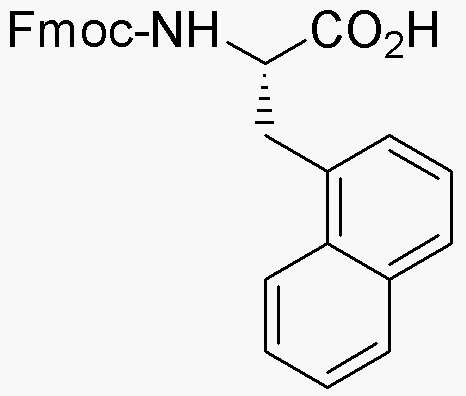Fmoc-3-(1-naphthyl)-L-alanine is widely utilized in research focused on:
- Peptide Synthesis: This compound serves as a protective group in solid-phase peptide synthesis, allowing for the selective modification of amino acids without interfering with other functional groups.
- Drug Development: Its unique structure aids in the design of peptide-based therapeutics, particularly in targeting specific biological pathways, enhancing drug efficacy.
- Bioconjugation: The compound is used in bioconjugation processes, facilitating the attachment of peptides to various biomolecules, which is crucial for developing targeted drug delivery systems.
- Fluorescent Probes: It can be incorporated into fluorescent probes for imaging applications in biological research, providing insights into cellular processes.
- Research in Neuroscience: The compound is explored in studies related to neuropeptides, contributing to the understanding of neurological functions and potential treatments for neurodegenerative diseases.
Informations générales
Propriétés
Sécurité et réglementation
Applications
Fmoc-3-(1-naphthyl)-L-alanine is widely utilized in research focused on:
- Peptide Synthesis: This compound serves as a protective group in solid-phase peptide synthesis, allowing for the selective modification of amino acids without interfering with other functional groups.
- Drug Development: Its unique structure aids in the design of peptide-based therapeutics, particularly in targeting specific biological pathways, enhancing drug efficacy.
- Bioconjugation: The compound is used in bioconjugation processes, facilitating the attachment of peptides to various biomolecules, which is crucial for developing targeted drug delivery systems.
- Fluorescent Probes: It can be incorporated into fluorescent probes for imaging applications in biological research, providing insights into cellular processes.
- Research in Neuroscience: The compound is explored in studies related to neuropeptides, contributing to the understanding of neurological functions and potential treatments for neurodegenerative diseases.
Documents
Fiches de données de sécurité (FDS)
La FDS fournit des informations de sécurité complètes sur la manipulation, le stockage et l’élimination du produit.
Spécifications du produit (PS)
Le PS fournit une description complète des propriétés du produit, notamment sa composition chimique, son état physique, sa pureté et les exigences de stockage. Il détaille également les plages de qualité acceptables et les applications prévues du produit.
Certificats d'analyse (COA)
Recherchez des certificats d'analyse (COA) en saisissant le numéro de lot du produit. Les numéros de lot et de lot se trouvent sur l'étiquette d'un produit, après les mots « Lot » ou « Lot de fabrication ».
Numéro de catalogue
Numéro de lot/série
Certificats d'origine (COO)
Ce certificat d'exploitation confirme le pays dans lequel le produit a été fabriqué, et détaille également les matériaux et composants utilisés et s'il est issu de sources naturelles, synthétiques ou autres sources spécifiques. Ce certificat peut être requis pour les douanes, le commerce et la conformité réglementaire.
Numéro de catalogue
Numéro de lot/série
Fiches de données de sécurité (FDS)
La FDS fournit des informations de sécurité complètes sur la manipulation, le stockage et l’élimination du produit.
DownloadSpécifications du produit (PS)
Le PS fournit une description complète des propriétés du produit, notamment sa composition chimique, son état physique, sa pureté et les exigences de stockage. Il détaille également les plages de qualité acceptables et les applications prévues du produit.
DownloadCertificats d'analyse (COA)
Recherchez des certificats d'analyse (COA) en saisissant le numéro de lot du produit. Les numéros de lot et de lot se trouvent sur l'étiquette d'un produit, après les mots « Lot » ou « Lot de fabrication ».
Numéro de catalogue
Numéro de lot/série
Certificats d'origine (COO)
Ce certificat d'exploitation confirme le pays dans lequel le produit a été fabriqué, et détaille également les matériaux et composants utilisés et s'il est issu de sources naturelles, synthétiques ou autres sources spécifiques. Ce certificat peut être requis pour les douanes, le commerce et la conformité réglementaire.


